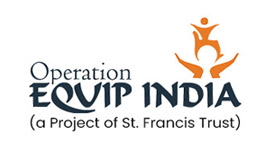Overview
Sports and Cultural Events
Sports and cultural events play a vital role in promoting inclusion, empowerment, and social integration for people with disabilities and their families. Operation Equip India (OEI) organizes a variety of sports and cultural events that provide a platform for individuals with disabilities to showcase their talents, enhance their physical and mental well-being, and foster a sense of community. These events not only celebrate the abilities and achievements of participants but also create awareness, promote inclusivity, and inspire others to overcome challenges. Through sports and cultural activities, OEI aims to create a supportive and inclusive environment where individuals with disabilities and their families can come together, connect, and thrive.
The Process
The process of organizing sports and cultural events for people with disabilities and their families at Operation Equip India (OEI) involves several steps:
Planning: The OEI team identifies suitable sports and cultural activities that can be organized, considering the interests and abilities of individuals with disabilities. The team collaborates with community members, local organizations, and partners to plan the events.
Outreach: OEI reaches out to individuals with disabilities and their families, spreading awareness about the upcoming sports and cultural events. They use various channels such as social media, local networks, and community gatherings to engage and inform potential participants.
Registration: Interested individuals and families register for the events by providing their details and preferences. OEI ensures that the registration process is accessible and inclusive for all participants.
Venue and Logistics: OEI arranges suitable venues for the events, ensuring accessibility and accommodation for individuals with disabilities. They coordinate with vendors and service providers to arrange necessary equipment, props, and facilities required for the activities.
Training and Rehearsals: Prior to the events, OEI may conduct training sessions and rehearsals for participants, providing them with the necessary skills and guidance to perform in the sports or cultural activities. This includes coaching for sports, practicing dance routines, or rehearsing for musical performances.
Event Execution: On the day of the event, the OEI team manages the logistics, sets up the venue, and ensures a smooth execution of the sports and cultural activities. They provide support, assistance, and any necessary accommodations for participants with disabilities.
Celebration and Recognition: The sports and cultural events are celebrated as a moment of joy, achievement, and inclusivity. OEI recognizes the efforts and talents of participants through certificates, awards, and public appreciation, promoting a sense of pride and motivation among individuals with disabilities and their families.
Follow-up and Feedback: OEI seeks feedback from participants and their families to assess the impact of the events and identify areas for improvement. This feedback helps in refining future sports and cultural activities, ensuring they continue to meet the needs and aspirations of the community.
Overall, the process involves careful planning, engagement, and execution to create inclusive and memorable sports and cultural events for people with disabilities and their families.
Inclusive sports and cultural events empowering individuals with disabilities and their families to showcase their talents and celebrate diversity.
FAQ's
Few of the most asked questions – answered.
OEI organizes a variety of sports events such as wheelchair basketball, para-athletics and inclusive games to promote inclusivity and physical fitness.
Yes, the sports and cultural events organized by OEI are open to individuals with various disabilities, including physical, sensory, and intellectual disabilities.
Yes, the sports and cultural events are designed to involve and engage the families of individuals with disabilities, fostering a sense of community and support.
Yes, OEI offers training and coaching sessions to participants to enhance their skills and prepare them for the sports events. This includes specialized training for specific sports disciplines.
Yes, in addition to sports events, OEI also organizes cultural events such as music performances, dance shows, art exhibitions, and talent showcases to celebrate the diverse talents and abilities of individuals with disabilities.
You can get involved by volunteering at the events, sponsoring or donating resources, or spreading awareness about the importance of inclusion and disability rights in sports and cultural activities.
Yes, OEI strives to organize sports and cultural events on a regular basis to provide ongoing opportunities for individuals with disabilities and their families to participate and engage in meaningful activities.
Sponsor a Health Service Today.
Looking for assistance?
Lorem ipsum dolor sit amet, consectetur adipiscing elit. Ut elit tellus, luctus nec ullamcorper mattis, pulvinar dapibus leo.

